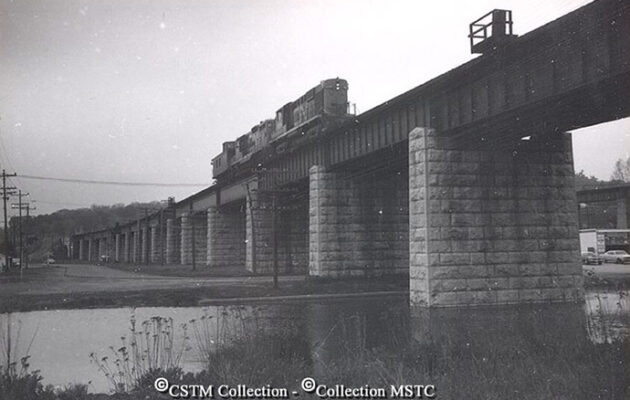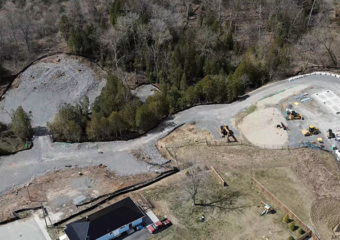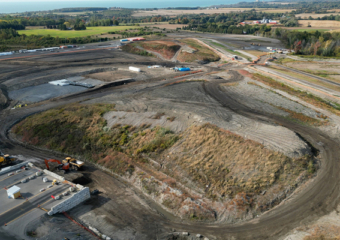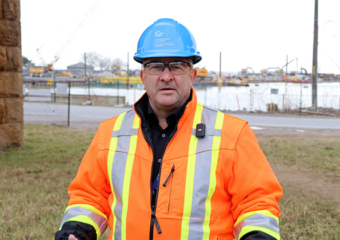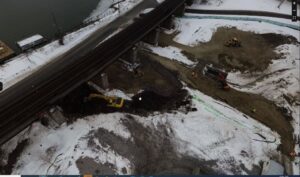 A familiar site as you navigate the streets close to the waterfront of Port Hope are huge stone pillars or piers that form the viaduct. The Port Hope viaduct was built by the Grand Trunk Railway in the 1850s to carry the railroad across the marshy land from the Port Hope harbour and was one of the most costly projects on the Grand Trunk Railway route between Toronto and Montreal. Construction on the main portion of the viaduct started in 1853 and was completed in 1856. Use of the rail line between Toronto and Montreal brought economic opportunities to Port Hope and greatly impacted the town’s industrial expansion and development, inspiring home building and population growth.
A familiar site as you navigate the streets close to the waterfront of Port Hope are huge stone pillars or piers that form the viaduct. The Port Hope viaduct was built by the Grand Trunk Railway in the 1850s to carry the railroad across the marshy land from the Port Hope harbour and was one of the most costly projects on the Grand Trunk Railway route between Toronto and Montreal. Construction on the main portion of the viaduct started in 1853 and was completed in 1856. Use of the rail line between Toronto and Montreal brought economic opportunities to Port Hope and greatly impacted the town’s industrial expansion and development, inspiring home building and population growth.
Now hundreds of years later, the CNL cleanup at the Port Hope viaducts is completed as part of Port Hope Area Initiative (PHAI) activities. The result of industrial practices starting in the 1930s led to the area under the viaducts being contaminated with low-level radioactive waste, primarily soil. The waste now removed has been transported to the waste management facility for long-term storage. Restoration of the site is now underway, with backfilling started and will include replacing the grass, trees and other plant species. . The site is expected to return to marshland over time.
“This was a particularly challenging site because of the marshy conditions. We had to dewater the area as we worked, as well as install temporary haul roads built with material suitable to handle the weight of the truck traffic per day,” shared Chris Bobzener manager of the project site.
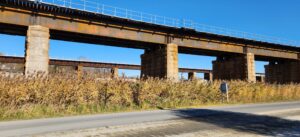 Cleaning up the site also included coordination with a number of different property owners as well as liaising with two major railway companies, Canadian National and Canadian Pacific, whose trains are also a familiar daily site in Port Hope. Special accommodations included a set back from the piers to avoid potential structural impacts when excavating, as well as ensuring a safe work site from flying objects off the rail line. In addition, a monarch butterfly habitat, identified by property owners, was cordoned off and maintained during the cleanup activities to safeguard and protect this identified species at risk.
Cleaning up the site also included coordination with a number of different property owners as well as liaising with two major railway companies, Canadian National and Canadian Pacific, whose trains are also a familiar daily site in Port Hope. Special accommodations included a set back from the piers to avoid potential structural impacts when excavating, as well as ensuring a safe work site from flying objects off the rail line. In addition, a monarch butterfly habitat, identified by property owners, was cordoned off and maintained during the cleanup activities to safeguard and protect this identified species at risk.
Monarch butterflies prefer milkweed, goldenrod and asters for their habitation, all of which are found in abundance under the viaducts. For more information about CNL’s species at risk protocol you can visit the PHAI website (https://www.phai.ca/environmental-protection/species-at-risk/)
Although winter and early spring weather made the area swampier than the team would have liked, they were able to complete the work safely and on schedule in March 2023.
“We are pleased to have met this milestone with the project team. This is the third and final project under this package which included the Waterworks East and Mill Street sites. Everyone worked together to meet the demands of this unique project and we look forward to returning the properties to their owners,” added Bobzener.
Work at the waterfront continues at the Port Hope Harbour and Centre Pier sites and in the West Beach area. Additional information about other PHAI work is available on the website (https://www.phai.ca/port-hope-project/port-hope-project-sites/) or by contacting the PHAI public information office at 25 Henderson St. Port Hope 905-885-0291 or [email protected]

